

Edible forest garden at UD Children's Campus: youtube.com/watch?v=U7-Zi0JH0jg
Edible Forest Garden
Photos by Monica Moriak and Eric Ruth | Video by Isabel DiGiovanni June 24, 2019
UD students learn and help staff teach children where food comes from
On an overcast Saturday morning, staff and volunteers gathered at the Early Learning Center and Laboratory Preschool, both located on the University of Delaware’s Children’s Campus. With shovels and wheelbarrows in hand, they set about installing an edible forest garden.
This multilayer collection of fruit and nut trees, legumes, shrubs, roots and vegetables is comprised of many plants that provide at least one component — berries, leaves or other produce — that is edible with proper care and preparation. Additional plants provide vital services like attracting pollinators or providing nutrients to the soil and surrounding garden. Students at the Children’s Campus will learn about garden maintenance, food production and preparation. They’ll have an opportunity to explore and experience the smell, texture and taste of the plants as they grow.
“An edible forest garden is a layered garden or designed landscape that incorporates perennial groupings of plants to imitate a low-maintenance natural forest. You can differentiate this from your typical community vegetable garden because that would be something that would require annual maintenance and replanting,” said Anna Wik, assistant professor of landscape architecture in the College of Agriculture and Natural Resources. “In this case, we’re creating something that children can interact with year-round. They’ll be able to talk about the life cycle of plants and see things truly bear fruit year in and year out.”
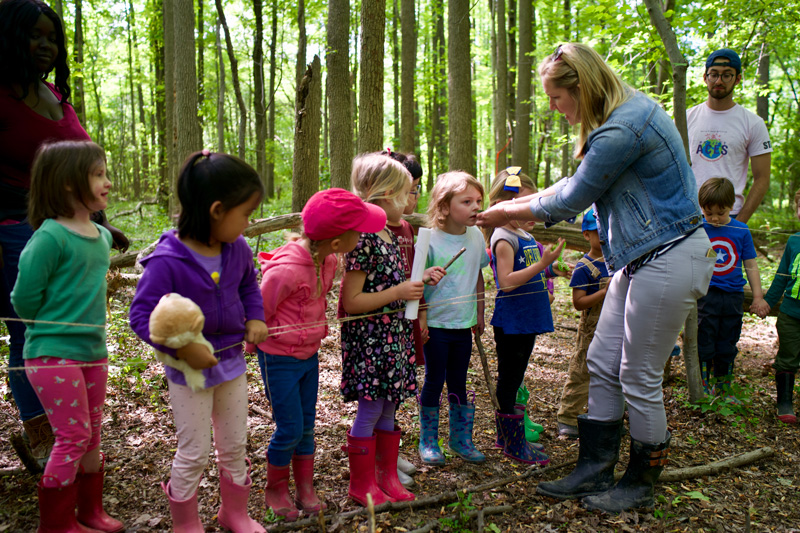
On that Saturday morning, the rain started out as a misty nuisance before growing into a steady downpour. Outfitted with rain ponchos and gardening gloves, the volunteers got to work distributing a truckload of topsoil to each of the new gardens, located at seven locations throughout the Children’s Campus. The volunteers numbered more than wheelbarrows, so the staff got creative, bringing out buckets and red wagons from the toddler playground to help move the soil.
Over the next few hours, volunteers installed nearly 200 plants and over 500 deep root landscape plugs that will eventually grow into UD’s first edible forest garden.
Building a forest
The garden planting is a major milestone in this cross-disciplinary project. Supported by a seed grant from the Center for Food Systems and Sustainability (CENFOODS), the edible forest garden is the culmination of a group effort from students, faculty and staff across five colleges and the University of Delaware Cooperative Extension.
“We’re a new Center on campus. We’re not specific to food and not specific to environmental sustainability; we’re really thinking about how the food system can be done in a way that’s more sustainable for society,” said Angelia Seyfferth, director of CENFOODS and associate professor of biogeochemistry and plant-soil interactions. “In addition to an internship program, the center integrates research, education, and community outreach. My hope is that we become an organization that provides internships and opportunities for undergraduates to be involved in research and local projects.”
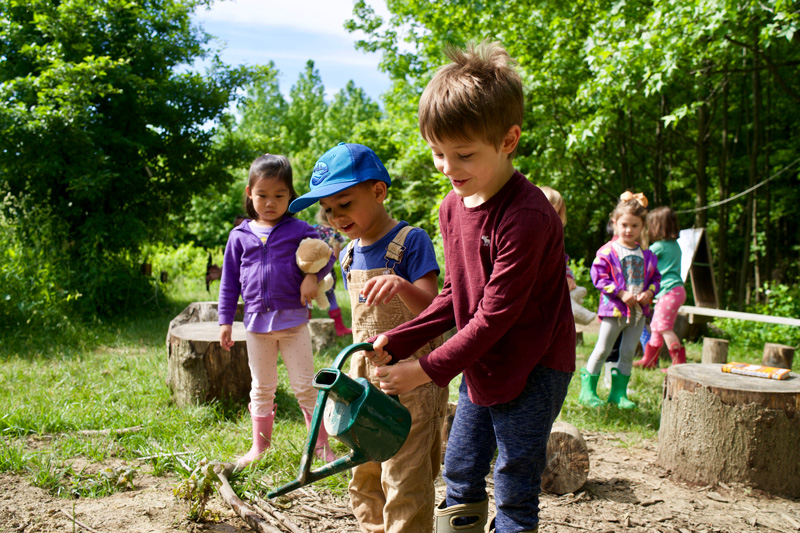
True to that vision, interns were at the helm of this project, gaining valuable work experience and honing their leadership skills. Sophomore Eduardo Limon and senior Jenna Simons were tasked with landscape design and plant selection. Senior Scott Walls led community engagement and recent alumnus Troy Saltiel used GIS to map productive landscapes across campus and document every plant in the edible forest garden design. Additional interns will draft a garden management plan this summer.
“This project was a really good opportunity for me to learn about native species and how their roots work, and to learn about the ecosystems we need to create to have successful gardens,” said landscape architecture student Eduardo Limon. “My goal is to become a licensed landscape architect and to create ecosystems that enhance the relationships between plants, animals, and people in the same landscape.”
Designing the edible forest garden was no small feat. Interns were fully immersed in what it means to be a landscape architect and had to learn and observe the needs of the client – in this case the children and teachers at the Children’s Campus.
“We were thinking about the landscape and the soil conditions, as well as how this design can be useful for children. I’ve visited two or three times to see how children play out here,” said Limon. “We brought ideas together and came up with some sketches. Then we started to think of various ways to design these places.”
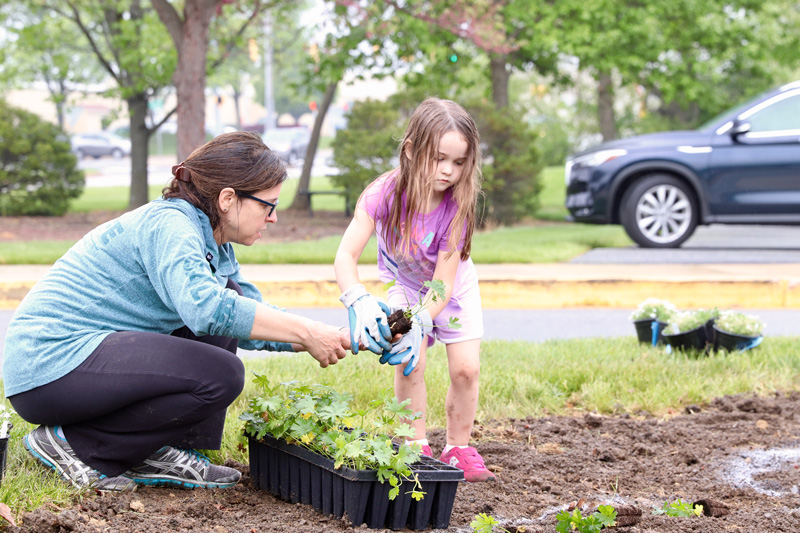
Plant selection and placement were critical as the purpose of an edible forest garden is to create a holistic multilayer ecosystem. “We have berries and other plants that could be used in teas or for a number of other uses,” Limon said at one of the garden sites. “The plants here have a symbiotic relationship; they work really well together as a group. For example, we have blue false indigo which provides all the surrounding plants with nitrogen. This plant fixes nitrogen from the atmosphere and introduces it into the soil. The surrounding plants then have more nitrogen accessible to their roots and they can produce more berries.”
Notable plants incorporated into the design include raspberry, blackberry, mint, fig, goldenrod, spicebush, potato bean and hog peanut. These were purposefully chosen for their potential as food producers or to attract pollinators.
“Already we are seeing the kids start to benefit. Just this morning I was talking to one of the teachers and she said that they’ve seen two new species of butterfly since the garden was established,” Wik said. “One of the biggest things we hope to foster here is a connection to nature, so kids can learn that plants and people can work together to increase ecosystem viability.”
Engaging young students
UD’s Children’s Campus is the perfect fit for a forest garden installation. In addition to enhancing the educational opportunities for children attending the three schools located on campus, the project’s close proximity to the James F. Hall Trail, which traverses three city parks and several major thoroughfares just south of Newark, is ideal for engaging the public through educational demonstrations and signage identifying plant species.
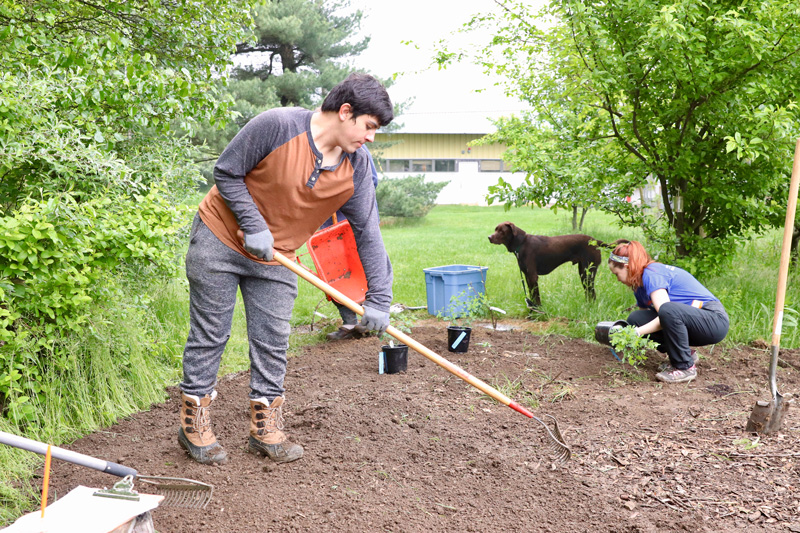
However, instead of installing the food forest on a single, centralized location on the Children’s Campus, the project’s designers opted to develop “sites” located throughout the campus to create a cohesive learning experience that is mindful of student learning goals and promotes connections between the schools on the Children’s Campus.
“Our curriculum is very sensory-based: feeling, seeing, smelling, tasting,” said Kelly Freel, associate director of infants and toddlers at the Early Learning Center. “So now that we have all of these other types of plant systems being added to our environment, we want children to reflect on how we are interacting with these systems along with other animals and insects.”
Teachers plan to incorporate the garden into existing outdoor learning curriculum. For example, this past year, students at the Laboratory Preschool completed a learning unit on fungi. There was an abundance of jelly fungus and some turkey tail fungus that was sporadically popping up around campus. Under close faculty supervision, students harvested fungi spores by peeling back the crumbling layers of a rotted log, observed them under microscopes and magnifying glasses, researched fungi species, how different species grow and so on.
“The children were fascinated by it,” said master teacher Katrina Pollock. “You'd be amazed by the ability of three- and four-year-old children to retain information if you present them with a cohesive learning experience. This includes not only the names of plants but also field observations: how the plants grow, how the plants communicate with other plants, how we can be stewards and care for plants and protect our forests because we want to keep our environment healthy.”
Pollock mentioned another recent learning experience involving the flood plain adjacent to the Children’s Campus, which attracts a lot of litter runoff.
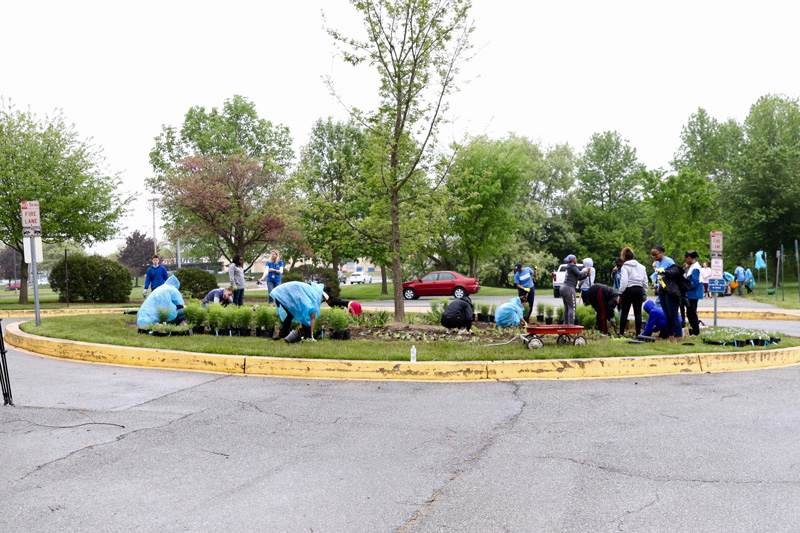
“And young children — one of the things I love about them — is they really cannot comprehend why there would be garbage,” Pollock said. “Why would there be garbage in the middle of their learning forest? And so that serves as an entry point for helping them understand the idea of choice, and the idea about making mindful choices, thoughtful choices, kind choices and how our choices impact other people.”
If you’d like to support future projects like this on UD’s Children’s Campus, click here to make a donation today.
About UD’s Children’s Campus
The Children's Campus at the University of Delaware is an approximately 15-acre site home to the Early Learning Center (ages 6 weeks to third grade), The Laboratory Preschool (ages 6 months to kindergarten) and The College School (first to eighth grades). Also located on-site are the University of Delaware Cooperative Extension Master Gardeners Program and the Center for Disabilities Studies.
Contact Us
Have a UDaily story idea?
Contact us at ocm@udel.edu
Members of the press
Contact us at 302-831-NEWS or visit the Media Relations website

